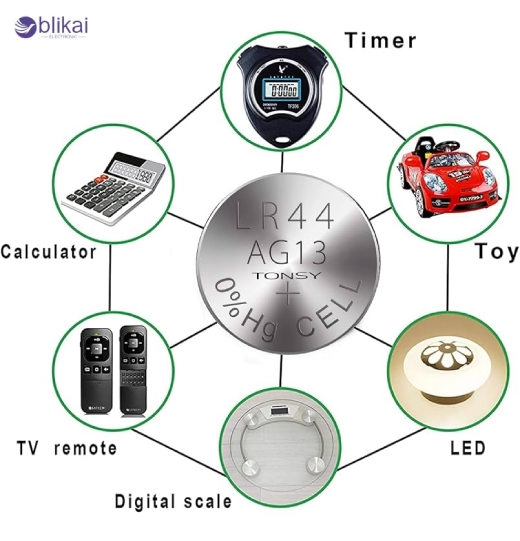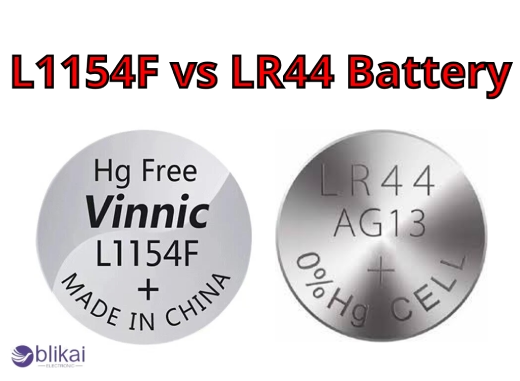L1154F vs LR44 Battery: Specs, Applications & Differences
What is an L1154F Battery?
Physical Characteristics
As a power source, the L1154F battery maintains a coin-shaped design with dimensions of 11.6 mm in diameter and 5.4 mm in height. A flat round body comprises the L1154F battery, which measures 11.6 mm from end to end but remains only 5.4 mm tall. Small electronic devices benefit from its compact dimensions to use this battery due to limited available space.
Chemical Composition
An alkaline battery makes up the fundamental composition of the L1154F battery system. A zinc-manganese dioxide chemistry inside allows the battery to produce a reliable power output. The battery's stability throughout time, along with its prolonged shelf life, results from its chemical composition.
Voltage and Capacity
L1154F batteries function with a regular voltage output of 1.5 volts. A device can operate using an L1154F battery for an estimated time based on its mAh capacity which ranges between 140 to 150 milliamp hours. The design of this power source works well for equipment needing continuous power delivery lasting an extended time with minimal power drain.
Common Uses
The L1154F operates in multiple small electronic devices because of its dimensions and electrical properties. The L1154F serves as a standard battery component for watches, cal, curators, and medical equipment, including glucose meters var, various toys, and specific versions of car keys. People choose this battery due to its dependable nature and extended operational life for devices needing sustained minimal power supply.
What is an LR44 Battery?
Physical Characteristics
The round-shaped LR44 battery functions as a button battery, known in the market as a button cell battery. Due to its measurements of 11.6mm diameter by 5.4mm height, the battery functions excellently in portable electronic devices. The LR44 battery design combines lightweight with its thin dimensions to easily fit inside restricted spaces of electronic devices.
Chemical Composition
LR44 batteries draw power with an alkaline system that combines alkaline manganese dioxide (Zn/MnO2) compounds. The combination inside the battery stays dependable for delivering power output from start to finish. The alkalinity of the battery enables it to maintain an extended shelf life spanning five to seven years while properly stored.
Voltage and Capacity
The nominal voltage output of an LR44 battery stays steady at 1.5 volts before its power decreases at the end of its lifespan. The stable voltage output of this battery allows its use in various application scenarios. The typical capacity measurement of an LR44 battery amounts to 150 mAh, which strikes a suitable balance between its compact dimensions and electrical output for handheld devices.
L1154F vs LR44 Specifications Comparison
|
Feature |
L1154F |
LR44 |
|
Chemistry |
Alkaline |
Alkaline |
|
Voltage |
1.5V |
1.5V |
|
Diameter |
11.6 mm |
11.6 mm |
|
Height |
5.4 mm |
5.4 mm |
|
Capacity |
~110–150 mAh |
~110–150 mAh |
|
Common Equivalents |
AG13, A76, LR44 |
AG13, A76, 157, L1154 |
Key Differences Between L1154F and LR44
Interchangeability
L1154F and LR44 batteries are suitable replacements for each other but slight variations exist which affect their functionality in specific electronic devices. The battery replacements work interchangeably with most devices since they share similar functionality. The L1154F operates as an alkaline battery, yet it differs from the LR44 battery because that device employs either alkaline or silver oxide technology. A chemical composition difference results in minimal voltage differences together with reduced lifespan.
Performance in various devices
Different devices, along with their power specifications, determine the performance results of L1154F and LR44 batteries. Silver oxide LR44 batteries provide constant electrical voltage output during their operational life, which works best with accurate tools such as watches and calculators. L1154F, along with other alkaline versions, exhibit a reduced operational period, yet they operate successfully in tools needing minimal power, such as small toys and remote controls.
Availability and cost
LR44 batteries prevail as standard shopping items because they exist more widely in retail locations and are less expensive than L1154F batteries. L1154F batteries remain costlier than their widespread analogs, which are commonly available. The price of batteries depends on the brand name and the type, which can be either alkaline or silver oxide. L1154F batteries maintain availability even though they are not as frequently encountered as LR44 batteries since BLIKAI.COM and several retailers offer them for purchase. The selection between these two types of batteries will depend on your geographic accessibility combined with device compatibility requirements.
Applications of LR44 and L1154F Batteries
Electronics suitable for L1154F
The L1154F battery exists for multiple small electronic devices in various applications. Watchmakers and calculator creators, together with toy manufacturers, use this power source for their products. The battery power supply supports both laser pointers and certain medical tools, especially glucose meters.
Devices compatible with LR44
LR44 batteries serve as power sources in many compact electronic devices. Both batteries can be found in watches along with calculators and small toys, although they share identical uses. LR44 batteries serve as primary power sources in automobile key fobs, as well as digital thermometers and selected hearing aids.

Overlap in usage
L1154F and LR44 batteries share identical application areas such as watch and calculator operations as well as small electronic toy use. Watches, together with small electronic toys and calculators, employ these batteries. L1154F batteries share similar application territories with LR44 batteries because they equal each other in size and output capacity. When used for the same applications, these batteries operate simultaneously, hence leading to confusion between users. Device manufacturers provide specifications that determine which battery substitute is appropriate for replacement purposes to achieve the best outcome.
Alternatives and Equivalent Models
Equivalent Battery Models
The market provides alternative battery models that equal both L1154F and LR44 battery specifications. The AG13 battery functions equally well as an alternative to the LR44 because it contains identical technical specifications. The 357 battery serves as another interchangeable solution alongside the other options. Devices that use either battery type show no variations in operational performance when these batteries get substituted for one another.
Cross-Brand Compatibility
Each battery brand maintains its specific naming system for products that contain equivalent specifications. The battery manufactured by Energizer uses the name A76, but Duracell markets it under 76A as its brand variation. Consumers gain access to more replacement choices because of the capability of brand-to-brand battery compatibility.
Rechargeable Alternatives
The market provides sustainable rechargeable battery substitutes that replace the traditional functions of L1154F and LR44 batteries. Many applications benefit from using the rechargeable SR44 silver oxide battery, which serves as an LR44 replacement. People who buy rechargeable batteries at a higher initial cost will save money and protect the environment by using them across multiple device battery replacements.
|
Model |
Chemistry |
Voltage |
Notes / Compatibility |
|
Alkaline |
1.5V |
Direct replacement for LR44/L1154F |
|
|
Alkaline |
1.5V |
Common equivalent name, widely used |
|
|
Alkaline |
1.5V |
Similar size, interchangeable |
|
|
Silver Oxide |
1.55V |
Higher capacity, stable voltage |
|
|
Silver Oxide |
1.55V |
Recommended for watches and precision devices |
Choosing the Right Battery
Factors to consider
Multiple factors determine which battery should be picked between L1154F and LR44. Before choosing a battery type ensure your device supports the required specifications along with intended compatibility. Verify the battery specifications by consulting the manufacturer's guidelines to select a suitable type. The battery's power capacity and voltage level should become the next evaluation point for matching the requirements of your device. Batteries should be selected based on their stand-by life span along with their rate of power drainage, particularly for devices that experience periods without use. Take into account availability and cost factors since these aspects change based on supplier location.
When to use L1154F
The L1154F battery serves as an excellent power source for technological systems needing extra voltage strength. The battery model L1154F functions best when used with older electronic devices alongside equipment requiring specific voltage formats. You should use L1154F if the device demands this specific battery type or when you require increased battery life for your device. You should use L1154F batteries in medical devices together with calculators and particular types of watches.
When to prefer LR44
The most suitable power source for newer electronic devices remains the LR44 battery type. L1154F batteries remain more expensive than LR44 but both types can be easily found in the market. LR44 has become the standard power source for today's small electronic items which include digital thermometers as well as car key fobs and laser pointers. The LR44 battery presents a secure solution for all devices that do not mandate the use of L1154F.
Impact on device performance
When picking between the L1154F and LR44 models, both influence your device's operational performance in major ways. Electronic devices function at their best with the correct battery types installed for maximal longevity. The tiny differences between these two batteries result in performance-related modifications to device precision, operational run time, and system dependability. The performance of your device depends on following manufacturing guidelines, which protect your device from breakdowns and failures.
Conclusion
The L1154F and LR44 batteries share physical dimensions and supply the same voltage, but they differ through essential specifications. The L1154F silver oxide battery provides extended functionality because it maintains higher capacity and an extended lifespan for systems that need a continuous power supply. The LR44 alkaline battery proves to be more economical than the L1154F silver oxide battery when used in simple applications.
Related Articles
AG13 vs LR44: Key Differences, Compatibility & Applications
CR2032 vs LR44: Key Differences, Application & Battery Comparison
LR44 vs 357 Batteries: Differences, Equivalents & Application
L1154F Battery Equivalent:Description,Features and Applications
LR41 vs LR44: Everything You Need to Know (2024 Guide)
LR44 vs SR44: What's the Main Differences? (Guide)
LR44 vs 357: What's the Main Differences?
AG13 vs LR44: Key Differences, Compatibility & Applications
CR2032 vs LR44: Key Differences, Application & Battery Comparison
LR44 vs 357 Batteries: Differences, Equivalents & Application
Multimeter Reading Keeps Jumping
Radial vs Axial Capacitor: Whats the Differences?
What is an Air Core Inductor? [Everything Explained]
What Is An Amplifier for?











